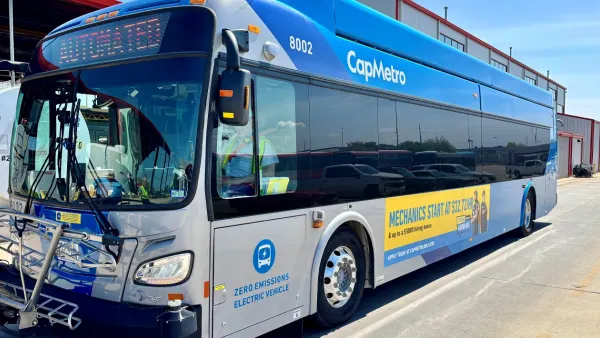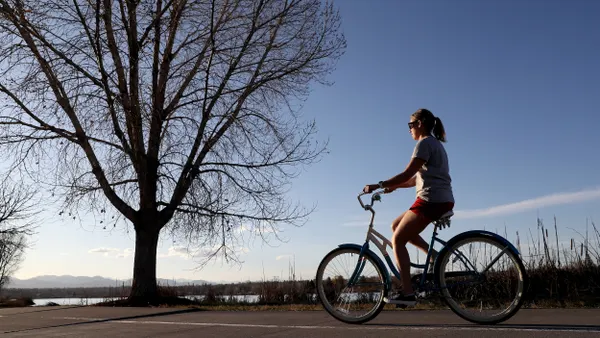ANN ARBOR, MI — The growth of autonomous vehicle (AV) usage around the country can benefit cities and their public transportation systems, but various issues remain, especially around public policy, equity of access and safety.
Those were some of the major takeaways from the Meeting of the Minds Mobility Summit last week in Ann Arbor, MI. Attended by more than 100 representatives from the public and private sectors, the one-day event brought panelists together to discuss issues around transit and AVs, as well as solutions.
Of the most concern to speakers was the need for equity and making sure everyone can access public transportation and ride-hailing such as Uber and Lyft. Pamela Lewis, director of the Michigan-based community foundation New Economy Initiative, noted that with 67% of Detroit residents making less than $50,000 a year and 25% not owning a car, there's a need for more options.
But Detroit’s Chief Mobility Innovation Officer Mark de la Vergne said the city, as one example, must rebuild after the financial struggles that left it bankrupt in 2013. The lack of city funds to dedicate to transit hit affordability and cut service, creating trust issues between Detroiters and their government. "It’s a big test, but there’s not just one symptom we can focus on, we have to look at them all to make things better," he said.
To combat that, de la Vergne touted the city’s efforts to pilot partnerships through its Detroit Mobility Innovation Initiative that looks to address mobility gaps. But, he said, it is incumbent on the city to make sure solutions work "for every single Detroiter," and that there is a way to pay for successful pilots to make them permanent. "For us, if we launch a pilot we can’t just pat ourselves on the back and say, ‘Great.’ We have to find a way to make it financially sustainable," he said.
The lack of equitable access to transit has also affected employment in other parts of Michigan, especially in the east of Washtenaw County that was once a manufacturing hotbed. With commutes by bus likely to take around an hour from that area to the University of Michigan, it makes life difficult for those without a car.
Meanwhile, some areas of the county have unemployment rates in double digits with people willing to work but unable to connect to job opportunities. In a speech, Teresa Gillotti, interim director of the Washtenaw County Office of Community and Economic Development, said "we need to find ways to connect to these neighborhoods where people want to work and aren't able to connect to those jobs," including to employment centers like metropolitan Detroit.
"You have wide variation in people's ability to get around even though we might say they live in a transit-rich neighborhood."

Alexandra Murphy
Assistant professor in sociology, University of Michigan
A new formula for transit accessibility
On the point of transit accessibility, there was a call for a new system to determine where the problem areas are nationally. Alexandra Murphy, an assistant professor in sociology and a faculty affiliate of the Population Studies Center at the Institute for Social Research at the University of Michigan, explained a model she has helped work on for several years called the Transportation Security Index.
Based on the U.S. Department of Agriculture’s Food Security Index, Murphy and her colleagues designed a measure to try and determine how people get around to consider nuances like how transportation affects their quality of life and their relationships.
Usual measures of transit accessibility look at car ownership, regardless of whether someone can afford to run that car, or use urban planning tools to determine how transit-rich a neighborhood is regardless of whether someone who is disabled has problems accessing it.
"You have wide variation in people's ability to get around even though we might say they live in a transit-rich neighborhood," Murphy said in a speech.
But in determining transit accessibility, some cities appear to have lagged, even in traditional centers for innovation. In a separate speech, Regina Clewlow, CEO and founder of transportation data platform Populous, said that cities in the Bay Area did not keep track of how many employees of big technology companies like Apple and Google used the shuttles provided for them to alleviate traffic congestion.
With that data now in place, Clewlow said it gives those cities a much better idea of what is being used. "We had no information on those services and how many people use those services," she said. "But it turns out that many people use them, often more than some of the major public transportation networks."
AVs could help build a strong transit network, solve 'first-mile, last-mile' problems
While some have expressed concerns that more AVs could result in greater traffic congestion on city streets that currently struggle to cope with standard ride-hailing, multiple speakers sounded an optimistic tone on the positive impact they can have, especially on microtransit.
Roger Millar, secretary of transportation in Washington State, said there have been calls in Seattle to use AVs purely to get people across some of the city’s bridges. But he said that with the city’s push for more light rail, Uber and Lyft can be used in other ways. "What I want that autonomous Uber or Lyft to do is take that person to the light rail station," he said. "It’s about the system, it’s not about the vehicles."
Leaders also agreed using AVs as part of a regional transportation plan is a good way to deploy them, something Millar said is "thinking about mobility in a context." Already there have been success stories with a recent push to regionalize Atlanta’s transit agencies under one body, while Andreas Mai, executive vice president at French transportation operator Keolis, pointed to the success in the French city of Bordeaux, which has done similar work to unite its regional offerings under one body.
But there is still plenty of work to be done, including in the Michigan area, with several speakers noting the need for better connections between the job hubs of Detroit and Ann Arbor. A new plan to move people between the two cities is in the early stages of development, and de la Vergne said leaders "really need to make this corridor work in a much greater way."
There were some hints at previous failures and tension on that, as Michigan transportation director Kirk Steudle indicated when he mentioned a failed bid to operate a train system. "We did our part, where were the rest of you?" he asked.
With the need for regional solutions and better integration of AVs, there needs to be cooperation between the public and private sectors, and across jurisdictional boundaries, to make it work.
"There's a whole lot of sticks on this side where if we don't work together between cities and the private sector to figure out the regulatory structure and how you get this all to work, it's going to be painful," Nico Larco, director of the Urbanism Next Center and a professor at the University of Oregon. "There's also this large carrot side, which is if we work together between the public sector and the private sector, and we have regional collaboration and regional coordination and we find models that work, then actually cities are creating value for the deployment of these technologies for these companies."
“I think that’s going to be the big decision: How good is good enough?”

Carla Bailo
President and CEO, Center for Automotive Research
Safety remains major stumbling-block for AVs
While there is plenty of optimism about what AVs can do to help transit systems, there remains lingering doubts over their safety, especially after high-profile crashes like the one in Tempe, AZ earlier this year that resulted in the death of a woman crossing the street. And while federal lawmakers move toward national standards for AVs, those safety concerns have caused legislation to get stuck in Congress, although there could be some movement soon, multiple sources told Smart Cities Dive last week.
Meanwhile, the major car and ride-hailing companies continue to test AVs, typically in closed environments. Panelists called for even more synergy between those companies, the public sector and academic institutions to write policies to govern the new technology.
And with that synergy, Carla Bailo, president and CEO at the Center for Automotive Research, said it can help things move quicker and give more clarity, especially through written policies. "In two to five years, the technology has eclipsed the standard you’re writing it for. We need to be faster," she said. "There’s so much we don’t know that we don’t know," Bailo continued.
John Maddox, CEO at the American Center for Mobility, added that within that greater push for safety there must be an understanding that test centers remain important to help iron out the kinks in the technology. And, he said, they can allow for testing for when sensors go wrong, so researchers can determine what redundancies to build in to try and avoid disaster.
"If you have a vehicle in Ann Arbor and a pedestrian crossing the street and it misses it, you can’t just ask them to go back and we’ll do it again," Maddox said.
In light of the death in Tempe, Bailo said companies testing AVs must do more due diligence, including on areas like safety drivers that may not have been of foremost concern before. Video from the city showed the safety driver was not paying attention to the road and did not react until it was too late.
She added that while AVs will reduce human error, it is up to the public and private sectors to decide how much risk they are willing to take on by rolling them out more widely, and how high safety standards must be compared to their human-controlled counterparts. "I think that’s going to be the big decision: How good is good enough?" she said.
The future is now
With conversations over public policy and safety concerns still ongoing, it could be easy to think that widespread AV use is still a way off. But as research and testing continue apace, speakers said that they could become standard sooner than some may realize, and it is incumbent on governments to be nimble and open to innovations. "We often say that cities that think ahead stay ahead," Larco said.
And there appears to be some urgency in finding solutions to transit gaps, including in Michigan which launched the Michigan Mobility Challenge earlier this month, a grant initiative by Gov. Rick Snyder to address such gaps. Steudle said that successful applicants must be able to provide a business plan in 30 days and show how they could implement a project in 45 days, and they must be effective. "These are not science projects. We don’t want any more science projects. We want something to solve problems today," he said.
Meanwhile in Las Vegas, the city’s first autonomous shuttles on public roads have become “generally accepted,” Mai said, despite a minor accident when a delivery truck backed into one. And Larco said that research from the likes of Waymo and General Motors on AV projects is bringing real progress. "It's incredible. I was like, 'This stuff is going to be a while.' This stuff is happening now. We'll all be able to go to Phoenix and get in an AV car in the next few months," he said.
But in developing this technology, Lewis said city and business leaders must be inclusive of all income levels and make sure AVs are not "a solution for those that already have access." She said it will also be important to "bridge the community’s voice to these mobility innovation companies," so nobody is left behind.











